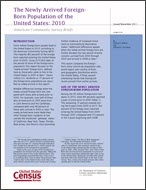The Newly Arrived Foreign-Born Population of the United States: 2010
The Newly Arrived Foreign-Born Population of the United States: 2010
Introduction
Forty million foreign-born people lived in the United States in 2010, according to the American Community Survey (ACS).1 The majority (83 percent) of the foreign born reported entering the United States prior to 2005. Using 2010 ACS data on the period of entry of the foreign-born population, this report focuses on the “newly arrived” foreign born, defined here as those who came to live in the United States in 2005 or later.2 Seven million U.S. residents or 17 percent of the foreign-born population are classified as newly arrived in this report.
Notable differences emerge when the newly arrived foreign born are compared with those who arrived prior to 2005. For example, over half of those who arrived prior to 2005 were born in Latin America and the Caribbean, compared with only 48 percent of those who arrived in 2005 or later. The newly arrived were more likely than other foreign-born residents to live outside the traditional “gateway” states of California, New York, Texas, Florida, New Jersey, and Illinois—thus providing further evidence of increased movement to nontraditional destination states.3 Additional differences appear when the newly arrived foreign born are further divided into two period-of-entry cohorts—arrived from 2005 through 2007 and arrived in 2008 or later.4
This report compares the foreign-born entry cohorts by population size, world region and country of birth, and geographic distribution within the United States. It finds several interesting trends that distinguish recent arrivals from earlier arrivals.
__________
1 The foreign-born population includes anyone who was not a U.S. citizen at birth, including those who have become U.S. citizens through naturalization. People born abroad of U.S. citizen parents are not included in the foreign-born population.
2 Data on the year of entry of the foreign-born population are derived from the question: “When did this person come to live in the United States?” The year respondents reported that they “came to live” is considered their “year of entry.” Respondents who “came to live” in the United States more than once were asked to report their most recent year of entry.
3 Audrey Singer, The Rise of New Immigrant Gateways, The Brookings Institution, 2004.
4 In this report the term “period-of-entry cohorts” refers to individuals who reported coming to live in the United States during specific periods of time: prior to 2005, 2005 through 2007, and 2008 or later. Note that the foreign-born population in a period of entry cohort represents immigrants who came to live in the United States during the specified time period and were still in the United States at the time of the survey. Thus, it does not include persons who subsequently died or left the United States.
Others in Series
Publication
Publication
Publication




